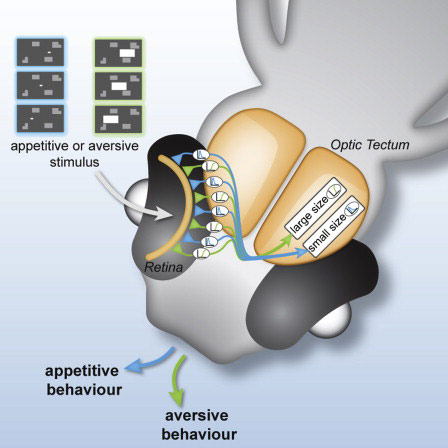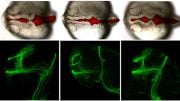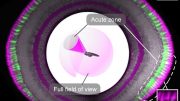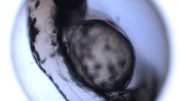
Small and large objects activate various circuits in the visual system of zebrafish larvae. This separation begins in the eye and probably decides the direction of the swimming behavior. Credit: Max Planck Institute for Medical Research
A new study from the Max Planck Institute for Medical Research reveals how the eye of a zebrafish larva can already distinguish between prey and predator.
Red or green? Small or large? Fast or slow? Humans and animals rely on their visual organs to classify objects in their environment. Decisions about how we best respond to moving objects in our environment are often made very quickly and unconsciously. The size of a moving object is obviously an important criterion. The rapid speed of response suggests that specialized neural circuits in the visual system are responsible for recognizing important object properties. If they are activated, they trigger the “fight” or “flight” signal in the brain. Scientists at the Max Planck Institute for Medical Research in Heidelberg have now shed light on how such circuits, which are likely to be crucial in classifying objects by size, function in the brain of the zebrafish larva.
How does the brain decide which things in our complex environment require an immediate response from us? A key question in the animal kingdom is: “Is the object moving in my environment prey or predator?” – a question that requires a quick answer in an emergency. Evidently, the visual system manages to detect objects from the constantly changing distribution of light stimuli on the retina based on simple criteria and, if necessary, mobilize a rapid response directly. The basic mechanisms of object classification can be studied using zebrafish larva as the model system.
The larva’s well-developed visual system allows it to catch small prey and avoid larger objects. The decision about whether the larva approaches or avoids the object is made on the basis of size. Researchers working with Johann Bollmann at the Max Planck Institute in Heidelberg have now been able to demonstrate that small and large stimuli, which trigger swimming movements in different directions, generate neural activity in neighboring but different circuits in the fish’s brain. The behavior-related distinction in size thus begins in the ganglion cells of the eye.
The retina in the eye contains a variety of different ganglion cells which respond specifically to color, size, movement or contrast, for example. However, little is understood about how these different messages travel via the optic nerve to the brain and are processed. The researchers were now able to identify such cells in a central area of the fish’s brain – the tectum. These cells respond specifically to those object sizes that correspond to a small prey or a large troublemaker in the world of the zebrafish larva.
It turns out that the nerve endings of ganglion cells, which project into the tectum, respond differently to object size. Other cell types downstream in the tectum distinguish between small and large objects on the zebrafish’s magnitude scale in their activity patterns, depending on the layer in which they receive their synaptic inputs.
“This suggests that the size classification process begins in the retina of the eye to subsequently classify the object that is seen in the tectum into the categories of ‘small enough to count as prey’ or ‘sufficiently large to watch out for’. The fish larva then adapts its behavior accordingly,” says Johann Bollmann from the Max Planck Institute for Medical Research. The brains of mammals contain very similar structures that are crucially involved in the visual control of such targeted movements. This suggests that the functions of detecting objects and controlling actions are resolved in a similar way as they are in the small brain of the fish larva.
Reference: “Classification of Object Size in Retinotectal Microcircuits” by Stephanie J. Preuss, Chintan A. Trivedi, Colette M. vom Berg-Maurer, Soojin Ryu and Johann H. Bollmann, 18 September 2014, Current Biology.
DOI: 10.1016/j.cub.2014.09.012









Be the first to comment on "Zebrafish Larva Eye Distinguishes Between Prey and Predator"